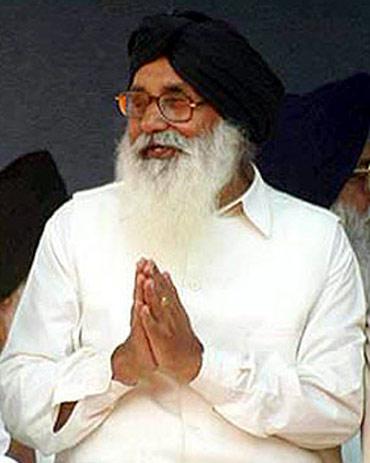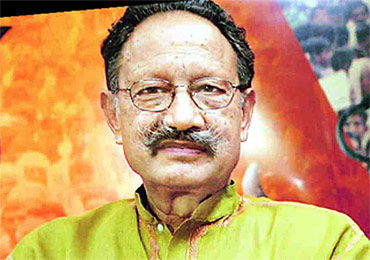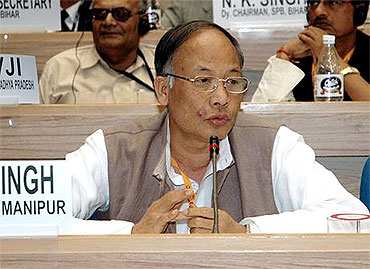Vicky Nanjappa
Uttar Pradesh Chief Minister Mayawati has assets worth a whopping Rs 87.27 crore, according to the National Election Watch, which has analysed the affidavits filed by the chief ministers of the five poll-bound states.
According to the organisation, Manipur Chief Minister Okram Ibobi Singh has assets worth only Rs 6.09 lakh.
Parkash Singh Badal, chief minister of Punjab, has a criminal case registered against him. He faces charges of cheating, forgery and criminal conspiracy. The other CMs are not facing any criminal charges.
Let us take a look at some of the other information obtained by the National Election Watch:
Punjab Chief Minister Parkash Singh Badal: He faces charges of criminal conspiracy, cheating and dishonestly inducing delivery of property, forgery of valuable security, will, forgery for purpose of cheating, using as genuine a forged document or electronic record.
He owns moveable assets worth Rs 2,54,63,551 and immoveable assets worth Rs 6,66,02,320.
Budget performance: Revenue expenditure increased in 2009-10 by 11.6 per cent. The increase was mainly due to increase under general education, pension, assignment to local bodies and Panchayati Raj Institutions and roads and bridges. Punjab has faced a revenue deficit since 2007-08 since revenue growth has failed to surpass revenue expenditure. Punjab has the fifth highest fiscal deficit of all States which is 3.6 per cent of its Gross State Domestic Product.
Reportage: Vicky Nanjappa
Mayawati has Rs 87 crore, Manipur CM has Rs 6 lakh
Image: Uttar Pradesh Chief Minister MayawatiUttar Pradesh Chief Minister Mayawati: Her moveable assets add up to Rs 12,57,50,000 and her immoveable assets account to up to Rs 74,69,92,000.
Budget performance: Revenue expenditure increased by 18 per cent in 2009-10, and significantly exceeded the assessment made by the government in the Fiscal Correction Path. Capital expenditure also increased by 12 per cent in 2009-10, mainly due to capital outlay on rural development programmes and procurement of food grains.
More than 50 per cent of the revenue income of the state comes from central sources in the form of either grants from the government of India or share of Union taxes.
It should be noted that the central government has been transferring a sizeable quantum of funds directly to the State Implementing Agencies for the implementation of various schemes/programmes in social and economic sectors recognised as critical. These funds are not routed through the State Budget/State Treasury System. The central government in 2009-10 transferred an additional Rs 13,710 crore directly to state implementing agencies such as the NREGS. The CAG has commented upon this saying it runs the risk of poor oversight of utilisation of funds.
In 2009-10, salaries, interests and pensions payments together comprise 59 per cent of all revenue expenditure. Salary Bill in 2009-10 as a percentage of revenue expenditure (net of interest payments and pensions) was 50 per cent, while the Twelfth Finance Commission norm was 35 per cent. Pension payments have risen by 177 per cent from Rs 3991 crore in 2005-06 to Rs. 11,007 crore in 2009-10. Pension payments in 2009-10 exceeded the projection of the Twelfth Finance Commission by 66 per cent. The government has introduced a Contributory Pension Scheme to mitigate impact of rising pension liabilities. In 2009-10, major sectors given subsidy were energy (38 per cent), rural development (28 per cent), agriculture (20 per cent) and irrigation and flood control (4 per cent).
Mayawati has Rs 87 crore, Manipur CM has Rs 6 lakh
Image: Uttarkhand Chief Minister Major General Bhuwan Chandra KhanduriUttarkhand Chief Minister Major General Bhuwan Chandra Khanduri: He has moveable assets worth Rs 1,21,72,131 and immoveable assets worth Rs 48,00,000. The total assets add up to Rs 1,69,72,131.
Budget performance: Uttarakhand is a Special Category State because of its mountainous terrain, due to which there are higher infrastructure and transaction costs, as well as higher costs of governance. This means that special privileges are given to Uttarakhand, including financial assistance from the Centre in the ratio of 90 per cent grant and 10 per cent loan, unlike non-special category states which get 70 per cent grant and 30 per cent loan.
Revenue Receipts were short by 13 per cent in 2009-10 due to less receipt under nontax revenue.
The State Government, in its Mid Term Policy Statement, attributed the shortfall revenue collection to the recession in the economy and financial burden that arose by Rs 2,500 crore after the implementation of Sixth Pay Commission recommendations.
Capital Expenditure in 2009-10 remained unutilised to the extent of 16 per cent, due to less disbursement under education, rural development and irrigation sector. Over the last 5 years, the budget projections for Revenue Deficit and Fiscal Deficit have not been achieved. The State could not achieve the fiscal deficit target of 4 per cent of Gross State Domestic Product as prescribed in the Fiscal Responsibility and Budgetary Management Act, 2005 for the year 2009䎞 which stood at 5.94 per cent.
Salaries, pensions and interest payments together consist of 72 per cent of the total revenue expenditure of the government in 2009-10, leaving a much smaller amount (Rs. 2,424 crore) of revenue expenditure to be spent on new social welfare schemes. This amounts to less than Rs 2,500 per person.
The Twelfth Finance Commission norms prescribe that expenditure under the salaries head should be 35 per cent of revenue expenditure while actual expenditure on salaries accounted for 53 per cent in 2009-2010.
Expenditure on salaries increased by 44 per cent from 2008-09 to 2009-10 due to the implementation of the Sixth Pay Commission.
Mayawati has Rs 87 crore, Manipur CM has Rs 6 lakh
Image: Manipur Chief Minister Okram Ibobi Singh:Manipur Chief Minister Okram Ibobi Singh: He has moveable assets worth Rs 2,69,472 and immoveable assets worth Rs 3,40,000.
Budget performance: Manipur is a Special Category State with a primarily agrarian population (76 per cent engaged in agriculture). Population density is low at 103 persons per sq km. The literacy rate is higher than that of the all-India average. The Gross State Domestic Product in 2009-10 showed a strong growth of 13.47 per cent. Cumulatively, the Compound Annual Growth Rate from 2000-09 was 11.91 per cent which is marginally higher than the other north-eastern states.
Revenue receipts increased marginally by 0.52 crore (0.01 per cent) over the previous year. Though tax revenue increased by Rs 25.97 crore and state's share of Union taxes and duties by Rs 16.75 crore, non–tax revenue and grants-in-aid from government of India decreased by Rs 13.71 crore and Rs 28.49 crore respectively, resulting in the stagnating position of revenue receipt.
Revenue expenditure and capital expenditure increased by Rs 392.12 crore (14.95 per cent) and Rs 120.98 crore (8.25 per cent) respectively in 2009-10 over the previous year. The fiscal deficit of the State increased threefold from Rs 217 crore in 2008-09 to Rs 733 crore in 2009-10. As a result, the ratio of fiscal seficit to GSDP increased from 2.83 per cent in 2008-09 to 8.43 per cent in 2009-10. This was mainly due to an increase in market borrowings.
Salaries, interest payments and pensions together consist of 45 per cent of the state's revenue expenditure in 2009-10. Salaries alone accounted for almost 30 per cent.
The Compounded Annual Growth Rate of Salary and Wages of the State from 2003-04 to 2008-09 is 10.36 per cent and was much higher than that of NE states (7.26 per cent).
Pension payments alone accounted for nearly 8 per cent of revenue receipts of the State during 2009-10 and increased by Rs 26 crore (10 per cent) from Rs 267 crore last year to Rs 293 crore.
The Compound Annual Growth rate of Interest Payment for Manipur between 2000-01 and 2008-2009 is 10.11 per cent, which was much higher than average north-east states (7.51 per cent); indicating that the state's economy was comparatively more stressed due to past liabilities.
Mayawati has Rs 87 crore, Manipur CM has Rs 6 lakh
Image: Goa Chief Minister Digambar KamathGoa Chief Minister Digambar Kamath: He has moveable assets worth Rs 2,15,10,815 and immoveable assets worth Rs 1,08,45,195.
Let us take a look at the performance of the state under his leadership.
Goa has a relatively low population density of 258 persons compared to all India average of 325 persons per sq. km. It also has one of the highest literacy rates of the states in the country, and one of the highest Compound Annual Growth Rates (14.35 per cent) of Gross State Domestic Product (GSDP) of the General Category States in the country.
Revenue receipt grew by 16 per cent in 2009-10 over the previous year mainly due to tax revenue.
Revenue expenditure increased by Rs 802 crore over the previous year. The increase was mainly under Education, Sports, Art and Culture (160 crore), Pension and Retirement benefits (129 crore), Power (76 crore) and Health and Family Welfare (53 crore). The fiscal deficit during 2009䎞 was 5.49 per cent of GSDP. In 2008䎝 and 2009䎞 the government of Goa has not received any debt waiver since the necessary conditions were not met -- the fiscal deficit of Goa was much higher than the ceiling of 3.5 per cent and 4 per cent respectively.
Salaries, interest payments and pensions together consist of almost 49 per cent of the state's revenue expenditure.
During the years 2008䎝 and 2009䎞, the expenditure on salaries increased by Rs 224 crore and Rs 268 crore respectively. The increase was mainly due to the payment of Sixth Pay Commission arrears to the government employees to the extent of 40 per cent in 2008䎝 and the remaining 60 per cent in 2009䎞. The entire arrears have already been paid with no further liability in future years.
Pension payments during 2009-10 increased by Rs 129.94 crore, a highest ever increase of 59 per cent over the previous year, mainly due to implementation of the Sixth Pay Commission's recommendations. The assessment made by the Twelfth Finance Commission was Rs 199 crore whereas the actual expenditure stood at Rs 350 crore.






article